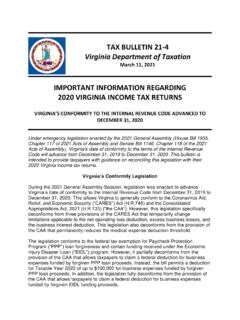Transcription of Evidence-Based Specially Designed Instruction in …
1 Evidence-Based Specially Designed INSTRUCTIONIN MATHEMATICSRESOURCE GUIDE2020 department of Special education and Student ServicesOffice of Special education Instructional ServicesDepartment of Learning and InnovationOffice of STEM and InnovationVISIONV irginia will maximize the potential of all mission of the Vir-ginia department of education is to advance equitable and innovative A. Gecker PresidentVIRGINIA STATE BOARD OF EDUCATIOND iane T. Atkinson Vice PresidentPamela Davis-VaughtDr. Francisco Dur n Anne B. HoltonDr. Keisha PextonDr. Tammy MannDr. Jamelle S. WilsonCORE SKILLSThe 5-C s are core skills that students and educators should possess: Critical Thinking Creative Thinking Communication Collaboration CitizenshipCORE VALUESCore Values are values that every employee of VDOE should embody: Inclusion Excellence Service OptimismVIRGINIA education LEADERSHIPDr.
2 James F. LaneSuperintendentof Public InstructionAtif Qarni Secretary of EducationRalph NorthamGovernor of VirginiaJenna Conway Chief School Readiness OfficerACKNOWLEDGEMENTSThe virginia department of education (VDOE) wishes to acknowledge all those who provided assistance in the development and review of this resource guide, including parents, VDOE Training and Technical Assistance Centers (TTAC), mathematics and special educators, community stakeholders, professional organizations, and university CO-AUTHORSKATHERINE BERRY, department of Special EducationUniversity of Texas at AustinSARAH POWELL, department of Special EducationUniversity of Texas at AustinVIRGINIA department OF EDUCATIONJAMES F. LANE, of Public InstructionSAMANTHA HOLLINS, Superintendent Special education and Student ServicesMICHAEL BOLLING, Superintendent department of Learning and InnovationPATRICIA ABRAMS, Special education Instructional ServicesTINA MANGLICMOT, Office of STEM and InnovationTERESA LEE, Special education Instructional ServicesTINA MAZZACANE, Mathematics Coordinator Office of STEM and InnovationDEBRA DELOZIER, Specialist Office of STEM and InnovationKRISTIN WILLIAMS, and Special education Specialist Office of STEM and InnovationPREFACEThe vision for K-12 mathematics education in the Commonwealth of virginia is that all students have access to high-quality, equitable, and engaging mathematics Instruction .
3 Students participate in relevant learning opportunities that develop both conceptual and procedural understanding. Teachers develop classroom communities that promote student ownership of learning through the use of mathematical discourse, problem solving, and rich tasks. Students and teachers exemplify resilience and a growth mindset, believing that all students can learn mathematics at high levels. This vision is for all students, including students with disabilities and diverse learning needs, and spans across the continuum of all to the Individuals with Disabilities education Improvement Act of 2004 (IDEA 2004), extensive research and experience has demonstrated that the education of children with disabilities can be made more effective with maintaining high expectations for students while ensuring their access to the general education curriculum in the regular classroom as appropriate.
4 The Regulations Governing Special education Programs for Children with Disabilities in virginia further explains that Least Restrictive Environment (LRE) means that to the maximum extent appropriate, children with disabilities, including children in public or private institutions or other care facilities, are educated with children who are not disabled, and that special classes, separate schooling or other removal of children with disabilities from the regular educational environment occurs only when the nature or severity of the disability is such that education in regular classes with the use of supplementary aids and services cannot be achieved satisfactorily (34 CFR through 34 CFR ). Review of school divisions LRE data in 2017-2018 virginia department of education (VDOE) Special education Annual Performance Report shows that 68% of students with disabilities in virginia s classrooms are spending at least 80% of their day in the general classroom.
5 However, according to the 2018-2019 State Performance Report, approximately 55% of students with disabilities passed the virginia Standards of Learning assessments in mathematics. Furthermore, statewide data show that achievement gaps in mathematics continue to exist for students with disabilities across the discrepancy in data may indicate that educators need more support and guidance in providing Specially Designed Instruction and appropriate accommodations to students with disabilities in the general classroom. In an effort to enhance the performance of students with disabilities in the mathematics classrooms, this resource guide serves as a resource for educators, administrators, and parents to address the educational needs of students with mathematics disability and/or mathematics difficulty.
6 This resource guide provides an overview of five Evidence-Based strategies that educators can utilize to support students with mathematics disability or difficulty at any grade. When delivering mathematics Instruction to students with mathematics difficulty at any grade level, teachers should incorporate the following practices, all of which have a strong evidence base: Explicit Instruction ; Formal Mathematical Language; Concrete-Representational-Abstract Connections; Fact and Computational Fluency; and Word-Problem Solving. Each of these practices will be addressed in this resource , this resource guide, along with the companion, Students with Disabilities in Mathematics Frequently Asked Questions Document, is intended to support any student who experiences mathematics difficulty with or without disability identification- in any setting.
7 For those schools who implement virginia Tiered System of Supports (VTSS) , many of the strategies outlined in the Frequently Asked Questions document could support Tier 1 Instruction , while many of the strategies outlined in this resource guide could support Tier 2 and Tier 3 Instruction . The virginia department of education (VDOE) and its department of Special education and Student Services and department of Learning and Innovation is committed to ensuring that the public education system is positioned to advance equitable academic outcomes by providing access to learning environments that meet the needs of its diverse student population. The Evidence-Based Specially Designed Instruction in Mathematics Resource Guide aligns with those efforts as it outlines effective supports for students with learning disabilities in mathematics and offers support to school divisions and parents seeking to improve outcomes in mathematics for students with disabilities.
8 It also serves as a reference for professional development and technical assistance from the 3 PREFACE 4 SECTION I: EXPLICIT Instruction 6 Definition of Explicit Instruction 6 Modeling 6 Supports During Modeling 7 Practice 9 Supports During Practice 10 Resources 11 SECTION II.
9 FORMAL MATHEMATICAL LANGUAGE 12 Formal Mathematics Language Strategies 14 Resources 17 SECTION III: CONCRETE, REPRESENTATIONAL, AND ABSTRACT CONNECTIONS 18 Concrete, Representational, and Abstract Connections 18 The Benefits of C-R-A Connections 19 Resources 24 SECTION IV: FACT AND COMPUTATIONAL FLUENCY 25 Definition and Importance 25 Strategies for Building Computational Fluency 25 Strategies for Building Fact Fluency 26 SECTION V: PROBLEM SOLVING 28 Strategies for Teaching Word Problem Solving 29 Schema Instruction for Solving Word Problems 31 Additive Schemas 32 Multiplicative Schemas 35 Resources 39 SECTION VI: APPENDICIES 40 Appendix A: Model for Explicit Instruction : Planning Guide 40 Appendix B: Formal Mathematics Language Graphic Organizers 41 Appendix C.
10 Mathematics Instructional Connections for Physical and Visual Representations 43 Appendix D: Fluency Games and Activities 48 Appendix E: Algorithms for Addition, Subtraction, Multiplication, and Division 51 Appendix F: Problem Solving Attack Strategies 57 Appendix G: Comprehensive Overview of Additive Schemas 58 Appendix H: Comprehensive Overview of Multiplicative Schemas 60 SECTION VIII: REFERENCES 62 virginia department OF education | I: EXPLICIT INSTRUCTIONDEFINITION OF EXPLICIT INSTRUCTIONE xplicit Instruction often is described as the cornerstone of effective mathematics Instruction for students with learning difficulties (Hudson et al., 2006; Jitendra et al., 2018; Witzel et al., 2003). Although many helpful models of explicit Instruction exist, the model developed by the National Center on Intensive Intervention (NCII) offers a valuable guide to understanding explicit Instruction .


















